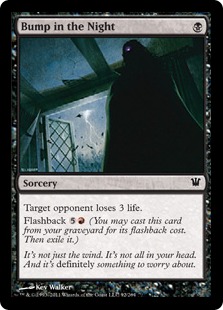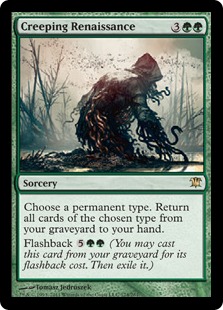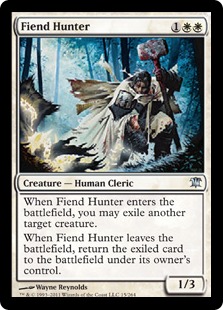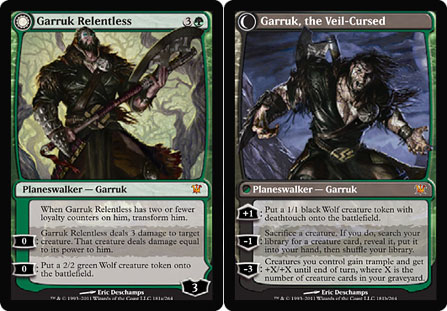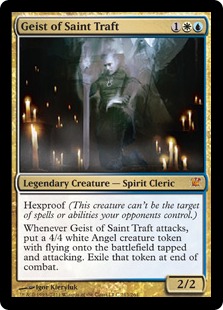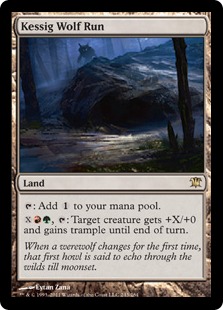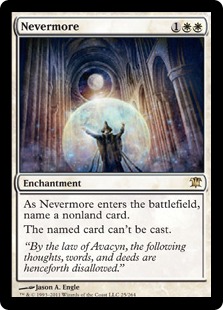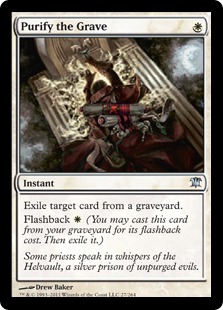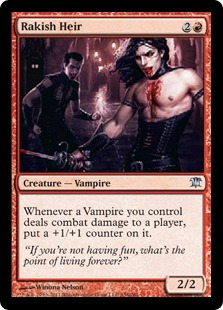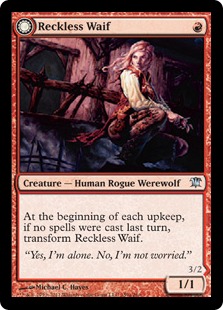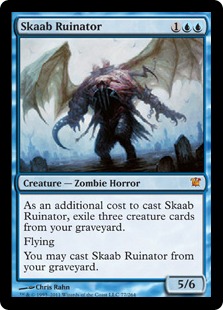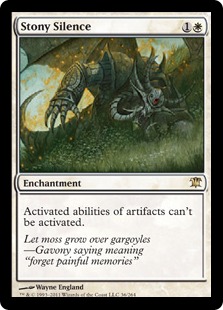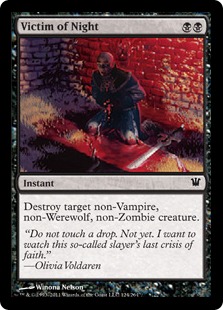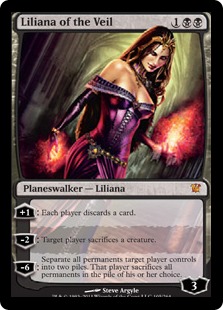Modern is looking far different than a month ago.
First of all, the September 20 bannings hit. Because of those, the format is practically already a brand new one, with several old decks made obsolete and several new decks scrabbling for a top position.
I won’t spend too much talking about the bannings in particular (though if you want to read my thoughts on them you can click here), but just know that the format is much different now. It’s not completely wide open, but there’s certainly a gaping fissure in the Modern landscape for new decks to march through.
More central to this article, a new set is upon us! Innistrad promises to make a big impact. Traditionally sets featuring graveyard-based strategies have a lot to add to older formats, and Innistrad is no exception. There’s quite a bit to talk about. In fact, there’s so much to talk about that it’s going to be split into two articles!
Here’s the deal. This article is going to highlight the new tools and centerpieces for beatdown and midrange decks from Innistrad. Later on in the week come back and check out part two, which will feature discussion of control and combo archetypes.
The one major thing I want to point about this system is that it means I will be discussing the same card multiple times. For example, I’ll be talking about the insane potential of Liliana of the Veil in this article in relation to beatdown and midrange and in the next article in relation to combo and control. This means that when I show off Liliana today in a beatdown and midrange deck and don’t mention her playability in Teachings or Reanimator, don’t worry: I’ll be going over that later in the week.
With that said, we have a lot to get through. Let’s get started!
Blasphemous Act
With a lot of the blue combo in rough shape, people may look to other forms of combo or just various combo/aggro hybrids. One such deck that some people ended up playing at the Pro Tour was Elves, and Blasphemous Act is a way for your beatdown deck to sweep a full Elves board for just a single mana.
This kind of effect is not to be overlooked when identifying ways to deal with their strategy. Unlike Firespout, it will kill your creatures too, but it’s much cheaper and ensures their lords don’t climb their Elves out of Firespout range.
Conclusion: Potential sideboard card.
Bramblecrush
I don’t anticipate this one getting played considering it’s just Rootgrapple with a slight discount, but at the same time I wouldn’t be surprised to see one played eventually. It’s the cleanest way to kill lands, artifacts, enchantments, and planeswalkers all in one card, and, unlike Oblivion Ring, you don’t risk them being able to reset it.
I don’t think pure beatdown decks will want this effect, and I can think of only a handful of midrange decks that would really want to play a card like this. For the most part, I think this one is going to stay on the benches and probably see some Standard play, but I’d guess somebody will eventually play a couple copies in their Modern sideboard as a catchall answer. (Though I can’t say I recommend it unless you really need this effect.)
Conclusion: An unlikely sideboard card.
Bump in the Night
This card is pretty straightforward. It’s Lava Spike, except that really late in the game it can be flashbacked. If you’re in the market for more Lava Spikes, it’s a consideration. However, considering that the only deck in that market is Burn, this card isn’t going to see a ton of play.
However, if Burn rises up (which it may be poised to do now that Glimmerpost is a nonissue and combo is a little slower), I could see some kind of Bump Burn build coming together. Perhaps it could use Dark Confidant in the sideboard as well. Stay tuned for a list later in this article after I talk about another card I want to try out in Burn.
Conclusion: Playable in decks that would like a better/an additional Lava Spike.
Creeping Renaissance
Creeping Renaissance is a unique and one-sided effect that can provide you with a ton of cards, and any card that does that is worth taking a look at. While I don’t think there’s any kind of sweet combo with this card, I do think it could potentially see play in the event that combo gets ironed out and midrange mirrors ever begin to happen in Modern.
Midrange decks are all about trading resources back and fourth. You’ll get Thoughtseized, some creatures will trade, removal spells will be cast, planeswalkers will get involved, and by the end of it you’re both left with empty hands and a full graveyard. This card sounds like basically the best possible card to draw in that situation. You just name creature, and it’s like a draw 7 of spells. I can’t imagine losing to a midrange opponent at that point assuming you’re at a stable life total. It’s the kind of card you only want one or two of, but it’s an absolute beating when you find it.
Bonus points if you ever choose the card type planeswalker and return multiple cards.
Conclusion: Potential sideboard card.
Fiend Hunter
This card is very exciting in Standard, but by the time you get back to Modern it’s less so. The removal is so good and the card pool so deep that it’s hard to consider a guy like this unless you’re playing mono white or need him for a humans linear or something. I thought about him in Zoo, but the body isn’t impressive, and if they just have a removal spell then they get to unlock their guy anyway.
The one place where I would expect him to see play is in Birthing Pod decks. I remember when I was working with Ben Hayes on a Birthing Pod deck for PT Philadelphia, we were both desperately trying to find a three drop that killed a creature (especially Gaddock Teeg) when it entered the battlefield. There were plenty of really awkward answers, but none that did the job universally and immediately.
Fiend Hunter is the piece to that puzzle we were missing. Granted, if you Pod him away, you unlock their creature, but hopefully it doesn’t matter by that point.
Conclusion: Fringe play, potentially used as a Birthing Pod target.
Garruk Relentless
Brand new planeswalkers are worth exploring, and Garruk is no exception. The question is: what kind of beatdown deck wants Garruk?
You can pick from any of the planeswalkers ever printed (well, okay, sans Jace, the Mind Sculptor) in Modern. So what factors would pull you toward Garruk Relentless over, say, Elspeth, Knight-Errant as a beatdown or midrange planeswalker?
The largest attracting factors that set Garruk apart has to be that he fights creatures and is splashable. Other planeswalkers all have ways to protect themselves and perpetually make creatures like Garruk can, but they can’t all be splashed and fight creatures.
The fight ability has some potential. You can lay Garruk, kill one of their creatures, and then pump out deathtouch wolves each turn. The two closest analogues to Garruk’s fight ability might be Gideon Jura and Chandra Nalaar. Unfortunately, I think Garruk ends up more Nalaar than Jura in that respect since its fight ability is essentially a one-shot effect, and it leaves him at only one or two loyalty. Both Gideon and Elspeth have been breakers against beatdown decks, and I don’t think Garruk comes close to being better than either.
That leaves one last hope for new Garruk: splashability. Is there a beatdown deck you would want to splash this in? Not really. Is there a midrange deck I would splash him in? Not really. With both of its primary assets spent, Garruk doesn’t have much of a home.
Sorry buddy.
Conclusion: Worse than other planeswalkers available.
Geist of Saint Traft
To make this Geist good, you have to find the situations where he’s going to be more than a one-shot 4/4. You don’t want to play him and just have your opponent block. There are so many powerful things you can do for three mana in Modern that four damage for three isn’t close to good enough. He isn’t good against most beatdown decks, and as a result I don’t think this guy is good enough for maindeck play.
The sideboard is a different story.
This seems like yet another card that could be awesome out of the sideboard of something like Counter-Cat against control decks. He hits for six damage a turn—an amount reasonably comparable to Tarmogoyf or Knight of the Reliquary—and they have to Pyroclasm, Firespout, or Wrath him away. While it’s likely there are better options (like more countermagic), I wouldn’t totally count the Geist out if the right situation arises.
Conclusion: A potential sideboard card against control decks.
Human Tribal
In addition to Vampires, I wanted to see if there were enough tools to build one of the other tribes: Humans. Humans seem pretty pushed in this set, and with plenty of Humans throughout Modern (in fact, the first block they appeared in was the first block in Modern: Mirrodin!), I wanted to give it a try.
I searched for a list and found 600+ humans to choose from! That’s quite the list. First I made a list of the ones from Innistrad worth trying in an aggressive Humans deck:
Then I looked through the list and pulled out other Modern legal cards that might fit:
Accorder Paladin
Akrasan Squire
Bant Sureblade
Borderland Ranger
Chameleon Colossus
Dark Confidant
Eternal Witness
Elite Vanguard
Ethersworn Canonist
Grand Abolisher
Gideon Jura
Grim Lavamancer
Hero of Bladehold
Knight of the Reliquary
Knight of the White Orchid
Knight of Sursi
Knight of the Holy Nimbus
Knotvine Paladin
Magus of the Moon
Master of the Wild Hunt
Meddling Mage
Mirran Crusader
Mirror Entity
Nekrataal
Noble Hierarch
Ninja of the Deep Hours
Ranger of Eos
Saffi Eriksdotter
Sigiled Paladin
Soul Warden
Soul’s Attendant
Steward of Valeron
Venser, Shaper Savant
And, of course, this deck could also make use of Aether Vial.
The problem is if you go straight G/W, you’re essentially a sitting duck to most combo and control decks because you have no good way to interact with them. As a result, you end up going either black or blue for disruption. (I ended up black because of Dark Confidant.)
I fooled around a little bit with G/W/B Humans that used the Saffi-Crypt Champion combo with Soul Warden and Champion of the Parish, but that deck is just better without the clunky Human pieces. (Not to mention, definitely not a beatdown deck.) If you want to go G/W/B beatdown Humans, I would try something like this:
Creatures (29)
- 4 Dark Confidant
- 4 Noble Hierarch
- 3 Knight of the Reliquary
- 4 Mirran Crusader
- 4 Accorder Paladin
- 2 Fiend Hunter
- 4 Hamlet Captain
- 4 Mayor of Avabruck
Lands (23)
Spells (8)

I’ll admit the mana base is certainly not the best, but I think you really want Mutavault in this deck.
Of course, any beatdown deck has to ask the question: is this better than Zoo? In this case, I don’t think it is—but it’s an interesting deck to consider nonetheless. On the midrange front, it reminds me more of Merfolk than Zoo, but Merfolk has the advantage of a more consistent mana base. Alas—something to toy around with.
Conclusion: Certainly fun, but not quite competitive enough. Perhaps keep an eye on the Human tribe as the block progresses.
Kessig Wolf Run
This card is interesting to me for one reason: you can Knight of the Reliquary for it. In beatdown mirrors where the games go long and you have tons of mana, it may not be unreasonable to tutor one of these up at some juncture so it makes blocking very difficult, lets your guys trade up, and pushes through some extra damage.
In midrange decks, it turns any single creature into a gigantic threat if you manage to Knight it up. Even if your board gets wiped, a lowly Birds of Paradise could easily represent 6+ damage. That’s something to be scared of.
I doubt the Wolf Run will see any heavy play in Modern, but it’s something you can at least consider.
Conclusion: Doubtful, but could be worth keeping in mind just in case.
Nevermore
First of all, I have to say it’s a travesty that there is no raven in this set that I can name with Nevermore. Just putting that out there and hoping that Dark Ascension helps fix this problem.
With that out of the way, this is a Meddling Mage that can’t be killed. Now normally, in a slower deck, these kinds of cards are iffy against combo decks because any good combo deck will have a bounce spell or other way to interact with a permanent. However, in an aggressive deck, these kinds of cards can buy you time to get in the two or so attacks you need.
Of course, unlike Mage, it’s not a clock. On the other hand if you draw multiples and name the right cards, you may be able to actually lock your combo opponent out of the game. Three mana is a little expensive, and decks with blue and white will often want Mage (or just countermagic) instead, but it is certainly a card to keep in mind.
Conclusion: Potential sideboard card.
Purify the Grave
It’s Coffin Purge! Except white.
When is this going to be better than something like Tormod’s Crypt? Either when surprise is a factor for you or, more likely, when you just have to hit a specific card. For example, against reanimator, Purify the Grave may be better than Crypt because you get two uses, and against that strategy you only need to target one specific card and that’s as they’re going off. On the flip side, if there was ever a Dredge-style deck, Tormod’s Crypt would be far better because you have to get rid of a high quantity of graveyard-based cards.
The question to ask: are they targeting one card in their graveyard, or using the whole thing as a resource? If the former, Purify the Grave is worth looking into.
Conclusion: Potential sideboard card.
Rakish Heir
The very first thing that leapt out at me from Innistrad was there were a lot of Vampires that could fit well with the ones in Zendikar. Of course, then I realized that those Vampires were all rotating from Standard. In Extended it is almost certainly a viable archetype. But could it potentially hold up in Modern?
Modern Vampires is an archetype that certainly has some hallmarks of success. Solid tribal creatures, strong removal, and plenty of disruption are all good signs. You can even play Vial! The mana is plenty fine to play full-on R/B Vampires, so the addition of red Vampires isn’t even an issue.
Unfortunately, the only new Vampire worth looking at is Rakish Heir. In a deck that’s all about pushing through small guys over and over, he fits perfectly. Plus, unlike Captivating Vampire, the bonus won’t go away if they kill him.
Unfortunately, the deck isn’t quite there yet. I played a couple games to be sure and, indeed, I was underwhelmed. Plus, the only card you want red for right now is Rakish Heir, which just isn’t worth it. I’d keep an eye on the Vampires tribe as Innistrad continues just in case though.
Conclusion: Not playable now, but maybe (although mostly unlikely) at some point in the future.
Reckless Waif
In general, I don’t think the Werewolves are very good in Modern. Players are casting cheap spells all of the time, and so keeping your opponent’s Werewolf locked into the human side doesn’t take too much effort. However, there is one Werewolf worth talking about because, for the price you pay, it promises a lot if it works out for you. That Werewolf is Reckless Waif.
Wild Nacatl is a creature that catapulted Zoo even further up the power scale. Three power for one mana doesn’t seem like that much more than Kird Ape, but in reality it’s often like a free Lightning Bolt over the course of the game.
I remember talking with well-respected Zoologist Brian Kowal, and he told me some statistic about how he kept track of when he had Nacatl on turn one versus when he had a two-power creature on the first turn. He was winning something like 30% more of his games when he had the Nacatl—that extra power adds up!
So, where does Reckless Waif fit into the Zoo picture?
The dream is clearly turn-one Waif on the play, watch your opponent grimace as they do nothing; then the Waif transforms and serves for three. But how often is that really going to happen?
With Preordain and Ponder banned, that certainly helps the Waif’s cause, though many combo decks will be switching over to Serum Visions and Sleight of Hand. The control decks may not have non-removal turn one or two plays anyway, meaning that the Waif will often be as good a Nacatl.
However, where Waif suffers the most is in beatdown mirrors. Your opponent is going to want to always have a one-drop—and worse yet, their one-drop is going to pretty much always outclass your Waif. You could skip playing a creature on your turn to flip your Werewolf over, but then you not only skipped your turn, but you also likely just end up trading with their creature thanks to the two toughness.
So to recap, it’s probably not good against combo, definitely not good against beatdown, and only decent against control. Sorry Waif—that’s not really what I’m looking for in an aggressive creature.
Conclusion: It’s a high variance card—except the twist is your opponent gets to control the variance by doing things they want to do anyway. Not playable in Modern.
Skaab Ruinator
This is a card that I’m sure will be tried in Modern… The only question is what it will take to make the card good. The first thing that I tried to do was dredging Stinkweed Imp, but there just aren’t enough good enablers to let that happen.
But, for the sake or argument, let’s say you manage to jump through blazing hoops and get an awesome Hedron Crab draw; your reward for all of your hard work is… a 5/6 flier on turn three? The sad truth is you could have probably just made infinity Pestermites or something with the same level of good draw it took to get the Ruinator online.
After experimenting with this card in Modern and Standard, it feels like this card is a clever trap: too much work, not enough payoff. Like several flashy rares in the past, it looks like it has a lot of potential, but eventually everyone realizes it takes too much to make it work. I can see Birthing Podding this guy up in Standard, but that’s about as far as I want to associate myself with this particular Skaab.
Conclusion: It’s a trap!
Snapcaster Mage
Everybody looks at Snapcaster Mage and begins to think so grandiose. They want to flashback Gifts Ungiven, or Time Warp, or Serum Visions or… (Don’t worry, we’ll get to some of those decks eventually.) However, what’s far easier to miss is the fact that Snapcaster Mage can also just be this:
Boltcaster Mage 1UR
Creature—Human Wizard
When Boltcaster Mage enters the battlefield, it deals three damage to target creature or player.
2/1
That card is absolutely insane! Yet, despite the relative insanity, I haven’t seen anybody just talk about slinging around Lightning Bolts at people.
Where does this fit? Well, it’s not so unreasonable to just include it in Burn!
Blue burn? Sure, why not! It’s likely going to squeak in at least one hit, making it five mana for three damage. It’s even a creature, so if you want to use it, Keldon Marauders, Mogg Fanatic, and Spark Elemental to help fuel something like Brimstone Volley you certainly could. (Though my build doesn’t.) Here’s something to try:
Creatures (20)
Lands (21)
Spells (19)

A little ambitious? Perhaps. It is likely stretching the mana too far to accommodate everything for very little gain; the splash for just Bump in the Night is probably better served as something else. On one hand, you can go further into the mono-burn strategy and cut cards like Lavamancer and Snapcaster; on the other you can just cut Bump and take the blue road. Either way, I think it’s interesting.
In any case, you need enough spells to make a card like Snapcaster good. Beatdown decks don’t always hit that threshold, though I could potentially see a few copies in Counter-Cat somewhere as a sweet way to reuse removal in the mirror. He’s probably at his weakest in beatdown—and even then, he’s no joke.
In midrange he certainly has some potential too. The trick is finding the midrange archetype with enough spells for him. The first blue midrange archetype that came to mind was Bant, which might look something like this:
Creatures (22)
- 4 Birds of Paradise
- 4 Tarmogoyf
- 3 Vendilion Clique
- 4 Noble Hierarch
- 3 Knight of the Reliquary
- 4 Snapcaster Mage
Planeswalkers (3)
Lands (22)
Spells (13)

Doubling up on Path or a counterspell, while not super flashy, is still pretty sick with Snapcaster. I don’t know if this is the best use of him in a midrange deck, but it is certainly very strong.
Of course, one of the other best interactions he has is with Aether Vial. Vial him in, and you don’t even have to put the two mana down to grant a card flashback! It’s an excellent aggro-control card. There’s so much you can do with Snapcaster Mage, and the ability is so powerful, so variance-reducing, and has so many unexplored, potentially abusable combinations that I wonder if it is a card Wizards will regret pushing. Regardless, the hype around the card is real: Snapcaster Mage is insane.
Conclusion: Yes, Snapcaster Mage is good. Beatdown might be his weakest archetype, but even when he’s Boltcasting and Pathcasting in beatdown, he’s still pretty insane. In midrange, he fits into a ton of places—the only question is where he will fit best.
Stony Silence
It’s Null Rod! Except likely even harder for artifact-based decks to deal with since it’s an enchantment. What you see is what you get here: if there’s an artifact deck out there that uses a lot of activated abilities, this is worth considering. Ironically it’s not as good against Affinity with the artifact lands banned as Null Rod was, but Stony Silence is certainly a card I would expect to be played at some point in the future.
This kind of card is especially good in beatdown decks because, if it shuts a deck off, you really only have to do it for a couple turns before you can kill them. That makes Stony Silence especially strong in decks like Zoo. Right now it’s not better than Ancient Grudge, but perhaps at some point in the future.
Conclusion: Potential sideboard card.
Victim of Night
Mirrodin Besieged brought us Go for the Throat, which has flickered in and out among decklists alongside Doom Blade. Now Innistrad brings us Victim of Night. Could Victim potentially overthrow the Besieged uncommon? Well, let’s take a look.
The biggest strike against Victim is the BB in its mana cost. In most decks, Go for the Throat or Doom Blade is going to be easier to cast, or Dismember will be cheaper, and so I imagine one of those will get the nod. So the assumption we have to go on to consider Victim is that we’re playing a deck that won’t have any trouble reliably having access to double black. At that point, how does Victim compare? Quite well!
Assuming casting Victim isn’t an issue, the drawback is going to be nearly non-existent in Modern. Vampires and Werewolves aren’t exactly running rampant, and facing up against Zombies, while present in a few fringe cases like Putrid Leech and Tidehollow Sculler, is going to be far less likely than running into a black or artifact creature.
Victim easily outclasses Doom Blade and Go for the Throat in the decks that can cast it. The only question then is if your deck would rather have Dismember. Dismember can’t always take down Tarmogoyf and Knight of the Reliquary though, plus it will occasionally cost you some life, so Victim is still a card to consider instead.
Victim is certainly not a card for all Modern decks. But if you’re a deck that can get BB reliably early on and doesn’t want more (or is already full of) Dismembers, then go for it!
Conclusion: Better than other removal spells if you’re in a very specific archetype.
Woodland Cemetery/Hinterland Harbor/Sulfur Falls/Isolated Chapel/Hilltop Retreat
These cards look like exactly what you get. No tricks here! We have experience playing with something pretty close in the core set dual lands. All I’ll say is that if your deck wants to cast a lot of one-drops, you’re going to be better off sticking with other dual lands. Even though these may be perfectly on color for you, that doesn’t mean you necessarily want to automatic play with them.
Conclusion: What you see is what you get: good lands that aren’t auto-includes in every deck.
Liliana of the Veil
Ah, yes, Liliana. I saved her for last. While Snapcaster Mage will ultimately end up being the best card in the set, Liliana of the Veil is an insane, insane planeswalker. When she was first previewed, a lot of players were unimpressed by her because of how simple her abilities look. However, while she’s not flashy or necessarily fun, she’s a perfect Spike planeswalker. Her abilities are selected to generate small incremental bonuses over the course of the game and bleed advantage from the opponent.
While I think Liliana fits in a lot of decks, and I’ll be going over those later on, one of my first reactions was, “How does control beat this card?” In Modern, that also applies to combo if you think you’ll be able to get in two Liliana activations
In beatdown decks, Liliana seems engineered as a way to demolish control and combo strategies. If you go one-drop, two-drop, Liliana and choose to keep using the discard ability each turn, control and combo are is going to be in a very hard place. I could see sideboarding it in Zoo decks that have access to BB (Dark Zoo or otherwise) just for these matchups.
Liliana isn’t even that shabby in beatdown mirrors. She’s an Edict at worst and can ensure that your opponent doesn’t get to hold any removal for your threats. If there’s a board stall, building toward her ultimate has the potential to break the game open.
Now, I could just show you some Zoo deck with Liliana sideboard, but where’s the fun in that? Here’s a beatdown archetype that is far more interesting and really puts her to good use:
Creatures (14)
Planeswalkers (4)
Lands (22)
Spells (20)

A couple other cards to consider are a single Mikokoro, Center of the Sea, red for Blightning and Rise / Fall, or green for Tarmogoyf and Treetop Village. If you play green it’s very difficult to also play Gatekeeper of Malakir though, and the one-two punch of Liliana and Gatekeeper seems incredible against other beatdown decks.
You’re a little soft to beatdown if you don’t draw your removal spells (you’ll want to board in Deathmark for sure), but you smash combo and control. Definitely give this deck a try!
Of course, one of the very first things I wanted to do was play turn one accelerator, turn two Liliana. (Second place might be cascading into it off of Bloodbraid Elf!) Turn-two Liliana completely backbreaking, and I can think of quite a few midrange decks that can put that to good use. Sure, I could slot her into something like Death Cloud, but a BUG deck like this is far more interesting:
Creatures (24)
Planeswalkers (4)
Lands (22)
Spells (10)

You’ll notice that this deck features four Liliana despite its being a planeswalker. First of all, I just think it’s that good.
Second of all, like Jace Beleren, Liliana is fragile and dies easily. If you play her and go -2 against beatdown, I wouldn’t expect her to live another turn—and the follow up Liliana will be even more devastating. Worst case, you can always discard excess Lilianas to her +1. If I have Liliana in play, I’m happy, and I want to draw her as often as possible, hence the full four copies.
This deck is another one that’s a lot of fun to play. It reminds me a lot of the BUG deck from Legacy, and I think something like this has a good chance at being a contender in the new Modern metagame. It has good creatures, disruption, and very strong individual card power.
The counterspells might be the weakest part of the deck, but I wanted some countermagic to keep them honest, plus I needed more spells for Snapcaster Mage.
Conclusion: Like Snapcaster Mage, Liliana is awesome, and you can expect me to say that several more times. It’s a great strategic Spike planeswalker that you can easily play four of. She’s going to see a ton of Standard play, and I don’t think Modern is far behind.
***
Well, that’s the first half down! Curious about anything I said? Think I missed a playable card? Post in the comments below, and I’d be happy to get back to you! If you’re not one for posting, feel free to send me a tweet or e-mail me at gavintriesagain at gmail dot com.
I’ve been having a ton of fun trying out these Innistrad cards. Don’t miss my second part later in the week where I cover Innistrad for control and combo in Modern! You won’t want to miss U/B control, a Heartless Summoning combo deck, my take on if Past in Flames is the real deal, and much more. I’ll see you guys then!
Gavin Verhey
Rabon on Magic Online, @GavinVerhey on Twitter
www.Designspaceblog.com



